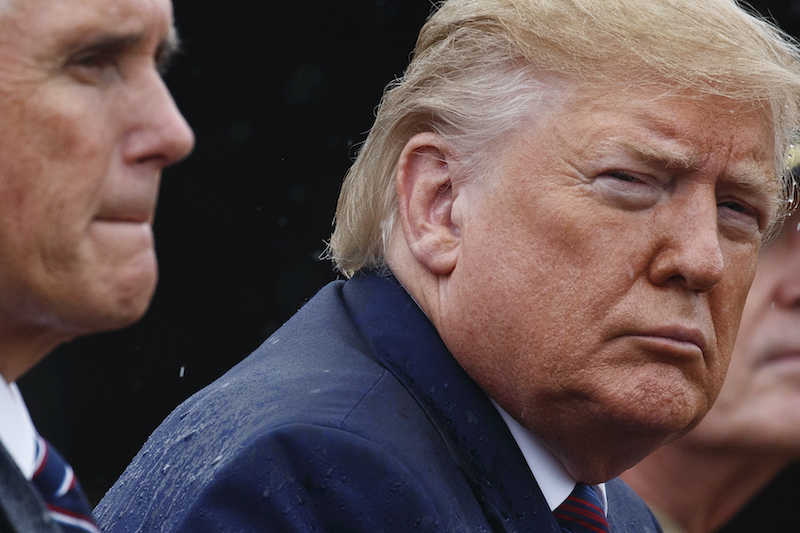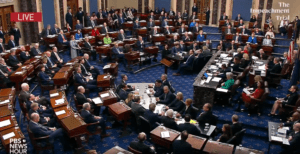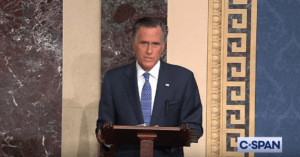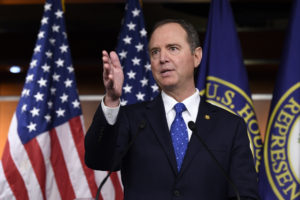Donald Trump Is Finished
Whether he’s ultimately convicted of impeachment in the Senate or not, it seems a foregone conclusion that he will not serve a second term. President Donald Trump, with Vice President Mike Pence at left, takes part in an Armed Forces event at Joint Base Myer-Henderson Hall, Va., on Monday. (Evan Vucci / AP)
President Donald Trump, with Vice President Mike Pence at left, takes part in an Armed Forces event at Joint Base Myer-Henderson Hall, Va., on Monday. (Evan Vucci / AP)
I’m not going to bury the lede: Donald John Trump, the 45th president of the United States, is going to be impeached. Not only that, but whether or not the GOP-controlled Senate convicts Trump of “high crimes and misdemeanors,” his presidency is drawing to a close. Unless a political deus ex machina comes to his rescue, he will not serve a second term.
Numerous actions and events have brought us to this impeachment precipice, virtually all of them initiated by Trump himself. He is the architect of his own demise, and there is no turning back.
As of Saturday, some 225 members of the House of Representatives were on record endorsing an impeachment investigation. Their ranks included independent Justin Amash of Michigan and Republican Mark Amodei of Nevada. The last high-profile House Democratic holdout, Tulsi Gabbard of Hawaii, announced her support Friday. The total will only expand in the coming weeks.
Trump, for his part, appears increasingly exhausted, paranoid and incoherent, not unlike Richard Nixon in the final stages of Watergate. The president has taken to Twitter even more than usual, spewing vitriol and blurting out threats of revenge against his many presumed enemies.
For those who are unfamiliar with the procedure or who could simply use a refresher, impeachment is the constitutional mechanism by which a president, vice president or “civil officer of the United States” can be accused of “treason, bribery or other high crimes and misdemeanors” and removed from office upon conviction.
The specific provisions governing the process can be found in Article 1, Section 2 and Article 2, Sections 3 and 4 of the Constitution, which define the respective powers of the legislative and executive branches of the federal government.
Together, the provisions establish a two-step process. As explained in a 2015 study, “Impeachment and Removal,” prepared by the nonpartisan Congressional Research Service: “First, a simple majority of the House impeaches—or formally approves allegations of wrongdoing amounting to an impeachable offense, known as articles of impeachment. The articles of impeachment are then forwarded to the Senate where the second proceeding takes place: an impeachment trial. If the Senate, by vote of a two-thirds majority, convicts the official of the alleged offenses, the result is removal from office. …” [Emphasis in original]
Although scores of federal officials have been the subject of congressional impeachment resolutions since the nation’s founding, the House has referred only 19 individuals to the Senate for impeachment trials—15 federal judges (including Supreme Court Justice Samuel Chase in 1805), one senator, one cabinet member and two presidents, Andrew Johnson in 1868 and Bill Clinton in 1998-99. The Senate has conducted 16 impeachment trials, convicting eight lower-court judges. The rest were acquitted.
Nixon, whose name is most often associated with impeachment, was never formally impeached. Rather than face certain conviction in the Senate, Nixon resigned before the full House could vote on three articles of impeachment passed by the Judiciary Committee in 1974.
As the accusatory body, the House has the authority to decide what constitutes an impeachable offense in any particular instance. The Constitution provides only general guidance, defining the grounds for impeachment as “treason, bribery and other high crimes and misdemeanors.”
While treason and bribery are clear enough, to grasp the meaning of “high crimes and misdemeanors”—the basis most commonly invoked over the decades and which will surely be cited against Trump—we have to look back to the Constitutional Convention of 1787.
The Founding Fathers debated impeachment and the notion of high crimes and misdemeanors extensively at the convention. James Madison described impeachment as “indispensable . . . for defending the community [against] the incapacity, negligence or perfidy of the chief magistrate.” George Mason argued, “No point is of more importance than that the right of impeachment should be continued. Shall any man be above justice?” Benjamin Franklin quipped dryly that impeachment was preferable to the European method of displacing a king—assassination.
But of all the Founders, Alexander Hamilton is credited with defining the scope of impeachment. In Federalist (Paper) No. 65 (1788), Hamilton described the legal process as embracing not only overt criminal conduct, but also serious violations of the “public trust.”
True to Hamilton’s reasoning, over the course of our history, charges of high crimes and misdemeanors have been alleged for a wide array of wrongdoing, both criminal and noncriminal, including abuse of power, obstruction of justice, corruption, bribery and perjury.
No one, not even Nixon, is more deserving of impeachment than Donald John Trump. In 2015, while Trump was a presidential candidate, I warned of the dangers he posed to immigrants, the First Amendment, and civil rights and liberties in general. Soon after the election, I began writing about his inevitable impeachment.
The principal debate now among mainstream Democrats and progressives is no longer whether Trump should be impeached, but how extensive the articles drafted against him should be. Well before the Ukraine scandal erupted into public view last week courtesy of a whistleblower’s complaint, Trump was liable for a long laundry list of impeachable offenses. Among the many derelictions I have cited, Trump can credibly be accused of:
- Committing campaign finance violations by paying hush money to two women with whom he allegedly had extramarital affairs, Karen McDougal and porn star Stormy Daniels;
- Obstructing justice in connection with the investigation by special counsel Robert Mueller;
- Defying congressional subpoenas;
- Using the presidency for personal economic gain;
- Abusing the pardon power to reward political allies;
- Attacking the press and the judiciary;
- Threatening to prosecute political opponents;
- Abusing emergency powers to build his border wall;
- Incarcerating undocumented immigrant children in concentration camps;
- Attempting to strip millions of Americans of health insurance;
- Promoting tax reform to benefit the super-rich;
- Gutting environmental regulations and pulling out of the Paris climate accord;
- Refusing to enforce the Voting Rights Act; and
- Curbing the use of federal consent decrees to counter police misconduct.
The mafia-like shakedown of Ukraine President Volodymyr Zelensky—as reflected in the declassified “Memorandum of Telephone Conversation” (memcon) that details the July 25 conversation between the leaders—only adds fuel to an already raging fire.
As shown by the memcon, which is organized in the form of an edited transcript, the American president promised to release American military assistance to Ukraine in return for a “favor”—that Zelensky use the power of his office to investigate alleged Ukrainian support for the Democrats during the 2016 American presidential campaign, as well as alleged corruption charges involving Joe Biden and his son Hunter. Trump urged Zelensky to talk to and “cooperate” with Attorney General William Barr and Trump’s private attorney, former New York City mayor Rudy Giuliani, for both purposes.
This is an abuse of power in black and white, aimed at using a foreign government to bring down a political rival. Arguably, it may also establish the elements of two federal felonies: extortion and bribery.
Since the release of the memcon, the Ukraine scandal has spiraled further out of control. Evoking memories of the Watergate coverup, it has been confirmed that White House lawyers ordered the original verbatim digitized transcript of Trump’s phone call with Zelensky be moved to a highly classified system maintained by the National Security Council, which is accessible only to a small circle of officials. It has also been reported that Trump has similarly restricted access to records of past conversations with Russian President Vladimir Putin and Saudi Crown Prince Mohammed bin Salman.
On Thursday, Trump upped the impeachment ante in a talk at a private event in New York. Comparing information leakers and whistleblowers to traitors deserving of the death penalty, he said: “You know what we used to do in the old days when we were smart? Right? The spies and treason, we used to handle it a little differently than we do now.”
Still, the issue of where to draw the line in the articles of impeachment against Trump is tricky. Impeachment is a political process, but it bears similarities to criminal prosecutions. And as any experienced defense attorney can tell you, more than a few strong prosecutions have failed due to overcharging, which can complicate, mar and muddy an otherwise straightforward narrative. (As a young lawyer, for example, I won the reversal of a defendant’s conviction of attempted murder that stemmed from overcharging, according to the published opinion issued by the California Court of Appeal.)
To tell the story of Trump’s malfeasance and corruption, three articles of impeachment, the same number that forced Nixon from the Oval Office, should suffice:
- Abuse of power for Ukraine.
- Using the presidency for personal gain.
- Obstruction of justice for the Mueller investigation and the wholesale defiance of congressional subpoenas.
Democrats have little to fear from a Trump impeachment. The current situation is much more akin to 1974, which saw Nixon’s popularity steadily erode until his resignation, than 1999, which saw Bill Clinton’s popularity climb. A CBS News Poll released Sunday showed a whopping 55% of respondents favor the impeachment inquiry. A Quinnipiac University Poll survey released on Monday went beyond the inquiry, finding respondents evenly split, 47 percent to 47 percent, on whether they support impeaching President Trump and removing him from office, a 10-point swing in favor of impeachment over a five-day period.
As the congressional impeachment hearings move forward, public support can be expected to increase. Even if the Senate refuses to convict, Trump’s reelection prospects will be crippled, as Democrats will be able to target Trump and the GOP in the 2020 elections for betraying the Constitution.
For the progressive left, impeachment presents a rare opportunity to hold a tyrant to account, and to merge the impeachment issue with a broader agenda for genuine social and political change. While some progressives may balk at forging a tactical alliance with mainstream Democrats, the choice should be a no-brainer. The impeachment train has left the station. Either get on board and help steer, stand aside, or get run over.
Your support matters…Independent journalism is under threat and overshadowed by heavily funded mainstream media.
You can help level the playing field. Become a member.
Your tax-deductible contribution keeps us digging beneath the headlines to give you thought-provoking, investigative reporting and analysis that unearths what's really happening- without compromise.
Give today to support our courageous, independent journalists.






You need to be a supporter to comment.
There are currently no responses to this article.
Be the first to respond.